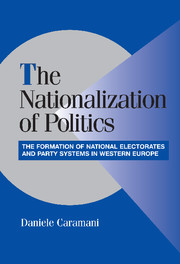 The Nationalization of Politics
The Nationalization of Politics Book contents
- Frontmatter
- Contents
- List of Tables
- List of Figures
- Abbreviations and Symbols
- Preface and Acknowledgments
- INTRODUCTION: HOMOGENEITY AND DIVERSITY IN EUROPE
- Part I Framework
- Part II Evidence
- Part III Toward an Explanation
- CONCLUSION: FROM TERRITORIAL TO FUNCTIONAL POLITICS
- Appendix 1 Party Codes
- Appendix 2 Territorial Units
- Appendix 3 Computations
- Appendix 4 Country Specificities
- Appendix 5 Sources
- References
- Index
- Cambridge Studies in Comparative Politics
CONCLUSION: FROM TERRITORIAL TO FUNCTIONAL POLITICS
Published online by Cambridge University Press: 02 December 2009
- Frontmatter
- Contents
- List of Tables
- List of Figures
- Abbreviations and Symbols
- Preface and Acknowledgments
- INTRODUCTION: HOMOGENEITY AND DIVERSITY IN EUROPE
- Part I Framework
- Part II Evidence
- Part III Toward an Explanation
- CONCLUSION: FROM TERRITORIAL TO FUNCTIONAL POLITICS
- Appendix 1 Party Codes
- Appendix 2 Territorial Units
- Appendix 3 Computations
- Appendix 4 Country Specificities
- Appendix 5 Sources
- References
- Index
- Cambridge Studies in Comparative Politics
Summary
The territorial distribution of social groups is a crucial dimension of conflict, as well as of conflict resolution. The ideal of homogeneous territorial nation-states has haunted Europe for centuries up to the present day. The correspondence between territory and culture – state and nation – has not only been the goal of nation-builders, but was also seen by peacemakers as the only viable solution to protracted conflicts. After World War I and II, borders were moved repeatedly in the attempt to fit groups and territories. However, only in a few cases was this carried out through democratic referenda, and where borders could not be moved, populations were transferred. In both cases, the solution was sought through territorial separation. Recently, this solution has proved viable in the former Czechoslovakia. Although territorial division was also adopted in some parts of the former Yugoslavia, in others it took the cruel form of “ethnic cleansing.”
For a long time, political theory too has supported the argument that liberal democracy was workable only within culturally homogeneous contexts, and only after the inclusion in international comparisons of multicultural cases – Belgium, the Netherlands, Switzerland – was this view amended, with important consequences today for normative democratic theory in multi- and postnational backgrounds. In Western Europe the different degrees of territoriality of ethnic and religious cleavages have led to different institutional arrangements.
- Type
- Chapter
- Information
- The Nationalization of PoliticsThe Formation of National Electorates and Party Systems in Western Europe, pp. 289 - 300Publisher: Cambridge University PressPrint publication year: 2004


